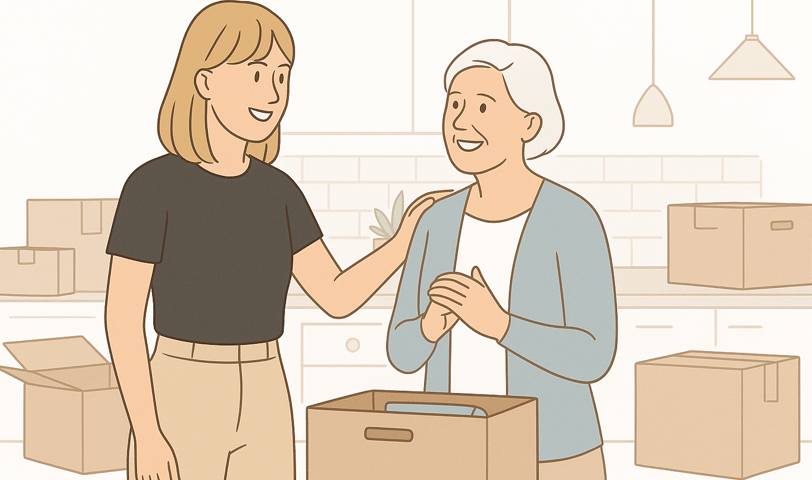The Essential Guide to Senior Downsizing and Moving in Miami
Learn how to simplify senior moves and downsizing with expert strategies. This Miami-focused guide covers emotional, practical, and safety considerations.
Magic Storage Touch | Gabrielle
5/5/20253 min read
🧳The Essential Guide to Senior Moving and Downsizing: How to Simplify the Transition with Care
Moving is considered one of the most stressful life events — even more so when it involves downsizing after decades in the same home. For seniors, the process is rarely just logistical. It’s emotional, layered, and often overwhelming.
Downsizing means making decisions about a lifetime’s worth of belongings, memories, routines, and space. For adult children or caregivers, this process can be just as complex — emotionally and practically.
This guide offers a clear, compassionate framework for simplifying senior transitions with dignity, efficiency, and expert support. Whether you're preparing for a move, right-sizing after retirement, or helping a loved one enter assisted living, these principles can reduce stress and make space for peace.
1. Understand the Emotional Weight of Letting Go
Downsizing isn’t simply decluttering — it’s a grieving process. The items in a senior’s home often represent identity, history, and a sense of continuity. Letting go of objects can feel like letting go of parts of life.
Professional organizers trained in senior transitions recognize this emotional layer and approach the process with patience, empathy, and permission to go slowly.
Psychological insight:
According to a 2018 study published in The Gerontologist, older adults experience higher emotional attachment to household items due to their symbolic meaning and association with life achievements.
2. Start Planning Early — Long Before the Move
One of the most common mistakes is waiting too long to begin. Starting early allows for:
Gradual sorting
Emotionally comfortable decision-making
Time to involve family without urgency
Organizers help create a phased plan, beginning with non-emotional areas (linen closets, pantries) and ending with more sentimental zones. This protects emotional bandwidth and reduces last-minute stress.
3. Use Category-Based Sorting, Not Just Rooms
Sorting room-by-room can be physically and emotionally draining. Instead, organizers guide seniors through category-based decluttering — one group at a time:
Kitchenware
Clothing
Sentimental items
Paper and files
Furniture
This method (inspired by cognitive-load research) helps reduce overwhelm and makes decision-making more manageable.
4. Involve the Right People — and Set Clear Roles
Well-meaning family members can sometimes add pressure. While emotional support is vital, organizing professionals act as neutral facilitators — especially helpful when adult children and parents have different emotional stakes.
Organizers:
Prevent tension by setting the pace
Offer decision-making frameworks
Mediate gently when opinions differ
In short, they help keep the process grounded and respectful.
5. Design the New Space Before You Pack
Moving into a smaller home, assisted living facility, or multigenerational setup requires planning the function of the new space — not just where boxes will go.
Organizers assist with:
Layout planning (using real measurements)
Prioritizing safety, accessibility, and comfort
Creating zones for continuity (e.g., bedside essentials, memory walls, reading nooks)
The goal is not just to move items — but to rebuild familiarity, autonomy, and peace in the new home.
6. Label and Structure for Memory and Routine
Transitions become especially complex when cognitive changes like dementia are involved. In these cases, labeling and visual clarity become essential tools — not just conveniences.
Professional organizers apply memory-support strategies such as:
Clear bin and drawer labels
Photo labels for common items
Consistent placement of essentials
Repetition of old patterns in new spaces
This reduces disorientation and helps restore confidence in the new environment.
7. Honor the Past While Making Room for the Present
Not everything must be kept — but not everything needs to be discarded either. The key is intentional preservation.
Organizers support this by:
Creating keepsake boxes or albums
Suggesting legacy projects (passing items to grandchildren, digitizing letters)
Offering creative ways to display treasured pieces in the new space
This approach allows seniors to carry their story forward without being overwhelmed by the volume.
8. Focus on Energy Conservation and Safety
Moving is physically taxing. Professional organizers not only reduce the labor involved, but they design systems that minimize future strain:
Avoiding bending and reaching for daily items
Ensuring clear walking paths
Reducing tripping hazards
Prioritizing rest areas within rooms
This makes the new space feel not only beautiful, but truly livable — day to day.
✨A Move That Preserves Dignity, Safety, and Peace
Senior transitions are deeply personal. They require more than checklists — they demand empathy, structure, and the ability to balance emotion with logistics.
Professional organizing brings calm, expertise, and respect to every step of the journey. From sorting memories to designing safe, personalized layouts, it’s about supporting this important chapter with the care it truly deserves.
If you or a loved one are navigating a move or preparing to downsize, our organizing services provide calm, respectful guidance tailored to your needs and timeline.
At Magic Storage Touch, we bring more than just hands — we bring heart.
_Gabrielle 💛


Presence in
Miami-Dade
Florida, United States
Contacts
786 514 8609
magicstoragetouch@gmail.com
